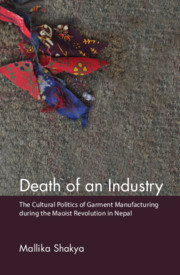 Death of an Industry
Death of an Industry Book contents
- Frontmatter
- Dedication
- Contents
- Figures and Table
- Abbreviations
- Key Names
- Acknowledgements
- 1 Situating the Idea: Industry, Society and Development
- 2 Nepal and Garments
- 3 A Garment Industry Ecosystem
- 4 The Normality of Garment Making
- 5 The MFA Expiry: A Garment Tsunami
- 6 Workers and Unions: Ethnicity and Class
- 7 Reconstituting the Garment Afterlife
- Bibliography
- Index
6 - Workers and Unions: Ethnicity and Class
Published online by Cambridge University Press: 08 July 2018
- Frontmatter
- Dedication
- Contents
- Figures and Table
- Abbreviations
- Key Names
- Acknowledgements
- 1 Situating the Idea: Industry, Society and Development
- 2 Nepal and Garments
- 3 A Garment Industry Ecosystem
- 4 The Normality of Garment Making
- 5 The MFA Expiry: A Garment Tsunami
- 6 Workers and Unions: Ethnicity and Class
- 7 Reconstituting the Garment Afterlife
- Bibliography
- Index
Summary
In the preceding two chapters, I discussed how ideas about garment workers largely embodied the situations of factory owners within the market economy, during both normalcy and crisis. This chapter depicts the world of workers in the context of the union movement, originating at a time of rupture and culminating during the phases of repair and reconfiguration, when the garment people were asking what development and democracy might mean for them. What cannot be denied about Nepal is that the garment workers were mired in controversies around class and cultural identity. Even when the industry was in full swing, generating as much as a quarter of Nepal's total exports, many called it a ‘dowry’ from India, because of the horde of Indians pouring through the open border. But the controversies about this industry's origins and roots became darker with the collapse of the industry itself, which essentially shifted the earth beneath the feet of those who drew their livelihoods and identities from garment.
At one level, the exodus became a marker of identity for garment workers from Nepal post-MFA, in that everybody who could get out of the industry and the country did so. Perhaps it is expected that poor workers in a poor country cannot afford to hang around factory shop floors after the collapse of their industry and the loss of their jobs. Jane Guyer (2004) talks about postcolonial economic domains being situated in a transcultural space between home and abroad. Even more relevant is Charles Piot's (2010) ethnography of the lotto visa applicants of Togo, among whom the enterprise of exodus ceased to become a rational necessity but has taken on a life of its own and produced its own excesses. Like the Togolese normalising their escape from joblessness and poverty through trans-Atlantic migration, the majority of former garment workers from Nepal now find themselves morphing into a new precariat labour force in geographies unknown to them, devoid of everyday citizenship and national belonging, as they are forced into toiling away in menial jobs in ‘emerging’ economic powers such as the Gulf or East Asia, if not in Europe and America. India alone is said to have absorbed over a million Nepalis, under a bilateral agreement which allows for an open border and easy work permits, a remnant of a controversial 1950 treaty that is both applauded and loathed in the region.
- Type
- Chapter
- Information
- Death of an IndustryThe Cultural Politics of Garment Manufacturing during the Maoist Revolution in Nepal, pp. 97 - 125Publisher: Cambridge University PressPrint publication year: 2018
